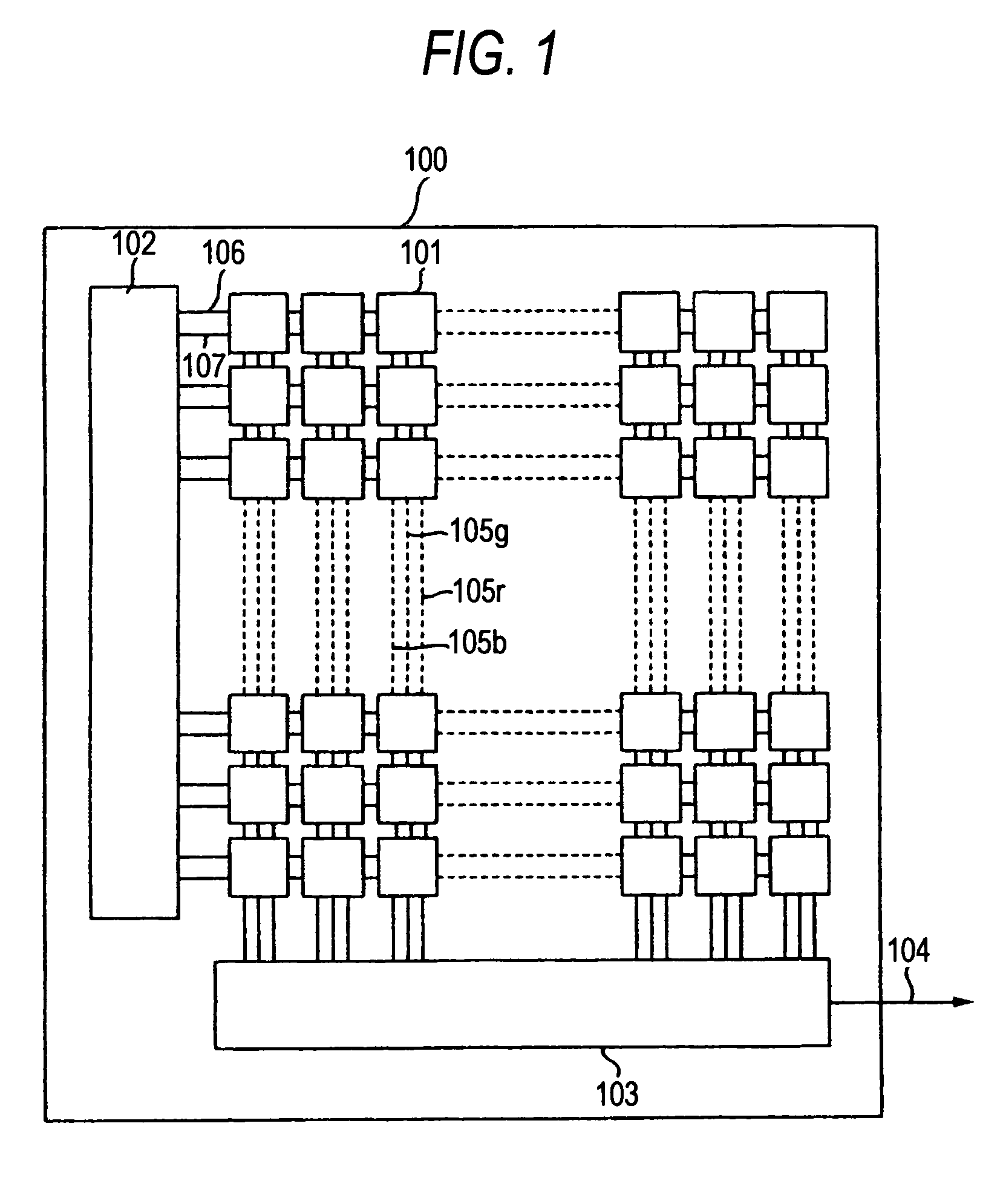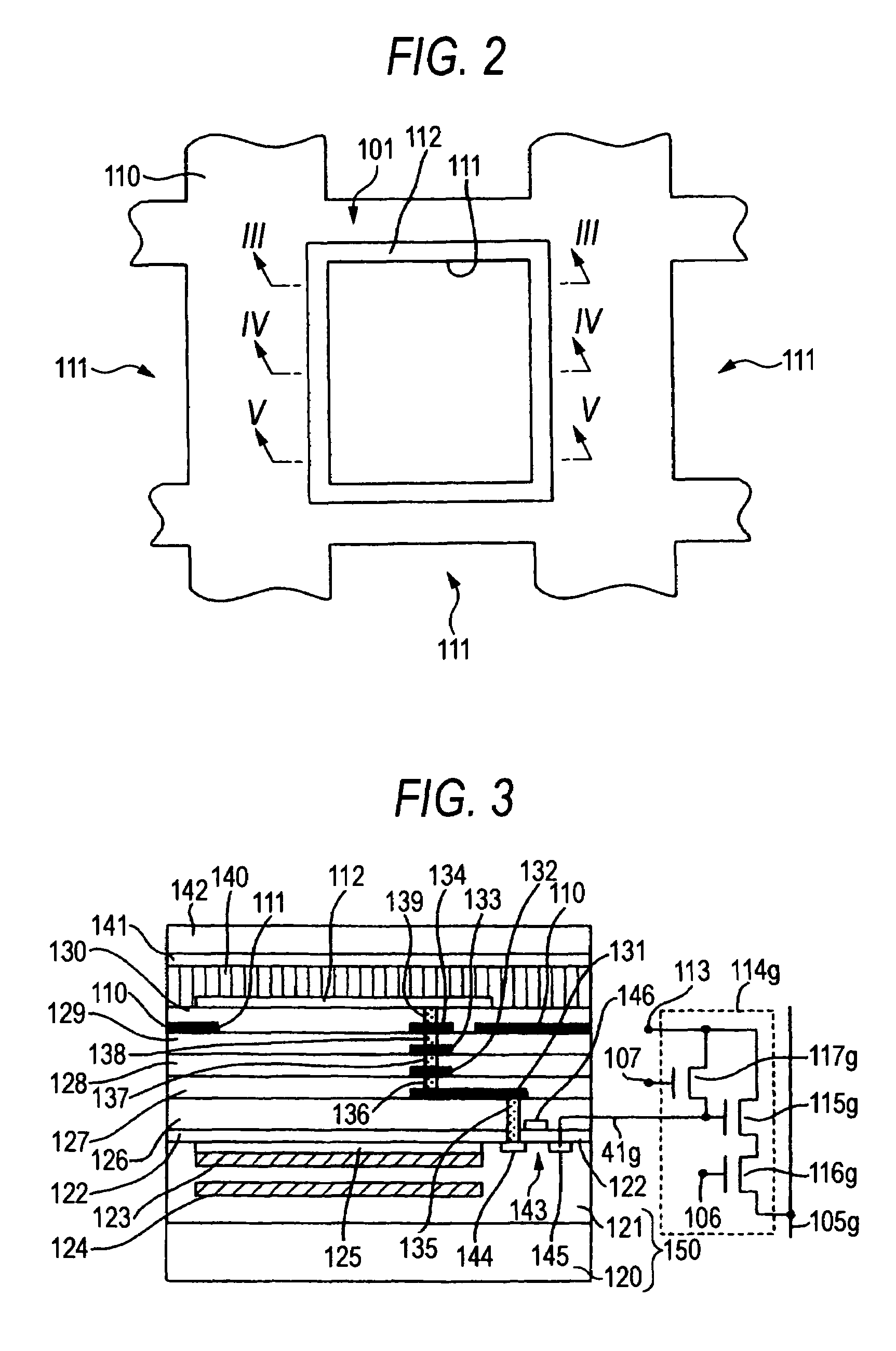Photoelectric conversion film laminated color solid-state imaging apparatus
a technology of photoelectric conversion and color solid-state imaging, which is applied in the direction of television system scanning details, radioation control devices, television systems, etc., can solve the problems of reducing light use efficiency, single color signal for each pixel, and reducing sensitivity, so as to prevent degradation of linearity of photoelectric conversion characteristics and high sensitivity
- Summary
- Abstract
- Description
- Claims
- Application Information
AI Technical Summary
Benefits of technology
Problems solved by technology
Method used
Image
Examples
first embodiment
[0060]FIG. 1 is a surface schematic view of photoelectric conversion film laminated color solid-state imaging apparatus according to the first embodiment of the invention. The photoelectric conversion film laminated color solid-state imaging apparatus 100 includes a large number of light receiving parts 101 in a tetragonal lattice in this example. On the surface of a semiconductor substrate of the photoelectric conversion film laminated color solid-state imaging apparatus 100 are formed a photodiode for detecting blue light and a photodiode for detecting red light mentioned later as well as a signal read circuit composed of a MOS transistor circuit by using a circuit integration technique. In the upper layer of the semiconductor substrate are laminated a photoelectric conversion film by way of a film forming technique.
[0061]Three signal read circuits provided for the light receiving parts 101 are interconnected via a row selection scan circuit 102, a row selection signal line 106 an...
second embodiment
[0092]FIG. 6 is a surface schematic view of photoelectric conversion film laminated color solid-state imaging apparatus 200 according to the second embodiment of the invention. The photoelectric conversion film laminated color solid-state imaging apparatus 200 differs from the photoelectric conversion film laminated color solid-state imaging apparatus 100 according to the first embodiment of the invention shown in FIG. 1 in that a read signal line 208 connecting a signal read circuit for each light receiving part 101 to a row selection scan part 102 is added.
[0093]FIGS. 7, 8 and 9 are respectively schematic cross-sectional views of the imaging apparatus according to this embodiment corresponding to FIGS. 3, 4 and 5 according to the first embodiment. A same sign is given to a same member as the first embodiment and the corresponding description is omitted.
[0094]In this embodiment, a potential barrier part 251b of a separate structure is provided in place of the potential barrier tran...
third embodiment
[0102]FIG. 10 is a surface schematic view of photoelectric conversion film laminated color solid-state imaging apparatus according to the third embodiment of the invention. While two n-type semiconductor layers 123, 124 are provided in the direction of depth of the semiconductor substrate and a blue color signal and a red color signal are separately detected by taking advantage of the wavelength dependency of the distance of entry of light in the first embodiment shown in FIG. 1, a color filter is used to separate a red color signal from a blue color signal to enhance the color separation performance, same as the related art practices. A red filter is formed at a light receiving part 101 bearing “R” in FIG. 1 and a blue filter is formed at a light receiving part 101 bearing “B”.
[0103]In this embodiment, a single light receiving part 101 is used to detect two colors of green and blue, and another light receiving part 101 adjacent thereto is used to detect two colors of green and red....
PUM
 Login to View More
Login to View More Abstract
Description
Claims
Application Information
 Login to View More
Login to View More - R&D
- Intellectual Property
- Life Sciences
- Materials
- Tech Scout
- Unparalleled Data Quality
- Higher Quality Content
- 60% Fewer Hallucinations
Browse by: Latest US Patents, China's latest patents, Technical Efficacy Thesaurus, Application Domain, Technology Topic, Popular Technical Reports.
© 2025 PatSnap. All rights reserved.Legal|Privacy policy|Modern Slavery Act Transparency Statement|Sitemap|About US| Contact US: help@patsnap.com



